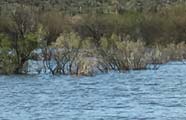All About Bass Fishing - Guide To Brush & Thick Vegetation
By Rick Seaman and Dan Westfall
 Brush is a universal cover for bass. Although the specific type of brush varies from one area to another, the bass and baitfish use most brush in the same way. It provides cover for predator and prey alike. Often a lake will contain multiple types of brush, and the bass may prefer one over the other. Sometimes it can be the major key to locating bass around the lake.
Brush is a universal cover for bass. Although the specific type of brush varies from one area to another, the bass and baitfish use most brush in the same way. It provides cover for predator and prey alike. Often a lake will contain multiple types of brush, and the bass may prefer one over the other. Sometimes it can be the major key to locating bass around the lake.
3 Most Important Factors About Bass Fishing in Brush & Thick Vegetation
- Bass hide deep in brush and ambush baitfish, sunfish and crawfish.
- The thicker the brush the safer the bass feels.
- Lure placement is critical based on water conditions and fish location.
3 Most Effective Fishing Methods & Lures
- Top water lures, spinnerbaits and flukes draw bass up out of the brush.
- Pitching artificial worms and Senkos to the concentration of branches around the brush.
- Flipping to the center and bottom of the heavy brush.
Vegetation and brush are excellent cover for bass
 Brush can be the ideal cover for bass, baitfish and other species of fish when conditions are right for them to spend time shallow. Identifying the type and placement of brush that is holding bass is important. Brush can exist out on the ends of points, back of the coves, on flats, along creek channels or anywhere in between. Once you can determine which of these areas holds bass, you can then begin to isolate on which specific brush.
Brush can be the ideal cover for bass, baitfish and other species of fish when conditions are right for them to spend time shallow. Identifying the type and placement of brush that is holding bass is important. Brush can exist out on the ends of points, back of the coves, on flats, along creek channels or anywhere in between. Once you can determine which of these areas holds bass, you can then begin to isolate on which specific brush.
Always start by fishing the brush which is farthest out into the lake, close to deeper water. If there is more than one type of brush, pay attention to which types are producing bass and which are not. As a general rule, the thicker the brush, the more likely it will hold bass. Brush with green vegetation will generally hold more bass than brush without vegetation. Be aware of the angle of the sun as bass will tend to hold in the shady side of the bush.
Start with top water, then spinnerbaits or crankbaits, then jigs or worms. In murky water it is important to fish close to the brush. Noisy lures also help attract bass out of the brush. If the brush is thick and the water is murky or even muddy, try flipping with a weedless jig or worm into the center of the brush. Use dark or brighter colors in murky water.
In clear water, bass will travel from farther away to attack lures. Long casts can be important to keep your presence from being so threatening. Begin with a top water bait or flukes fished near the surface. Then cast artificial worms or Senkos near the brush, allowing it to fall to the bottom. Begin by casting past the brush first, then cast to the front, working your way all around the brush.
AA Bass Fishing Knowledge Base
- Bass Fishing Overview
- Life Cycle Of Bass
- Seasonal Bass Migration
- Bass Migration - Mid to Late Winter
- Bass Migration - Spring
- Bass Migration - Early Summer
- Bass Migration - Late Summer
- Bass Migration - Fall
- Bass Migration - Early Winter
- Fishing For Bass
- It's Now WHAT You Throw, It's WHERE
- Research The Fishery Before You Go
- Review Contour Maps
- Types Of Cover Used By Bass
- Bass Fishing In Grass Beds
- Bass Fishing In Wood & Timber
- Bass Fishing In Brush & Vegetation
- Establishing Patterns
- Learn To Recognize Bites
- Review Lunar Tables
- Choose The Right Lures
- Find Bass Based On Conditions
- Conditions - Fold Fronts
- Conditions - Wind
- Conditions - Cloudy Days
- Conditions - Fishing In The Rain
- Conditions - Water Clarity
- Conditions - Rising Water
- Conditions - Falling Water
- Conditions - Fishing At Night
- Equipment & Tackle
- Equipment - Fishing Rods
- Equipment - Fishing Reels
- Equipment - Fishing Line
- Equipment - Fishing Lures
- Fishing With Live Bait
- Shallow Water Techniques, 0 -10'
- Shallow Fishing - Spinnerbaits
- Shallow Fishing - Crankbaits
- Shallow Fishing - Top Water
- Shallow Fishing - Pitching & Flipping
- Shallow Fishing - Artificial Worms
- Shallow Fishing - Jigs
- Shallow Fishing - Flukes
- Shallow Fishing - Stick Worms
- Shallow Fishing - Swimbaits
- Fishing Mid Range Depths, 10' - 25'
- Mid Depth - Spinnerbaits
- Mid Depth - Deep Diving Crankbaits
- Mid Depth - Artificial Worms
- Mid Depth - Jigs
- Mid Depth - Swimbaits
- Fishing Deep Water & Structure
- Fishing Deep Water - Jigs
- Fishing Deep Water - Jigging Spoons
- Fishing Deep Water - Artificial Worms
- Planning Your Attack
- Bass Fishing Questions & Answers
- Conservation - Protect The Fishery
Bass information by state
101624
Fishing Information



